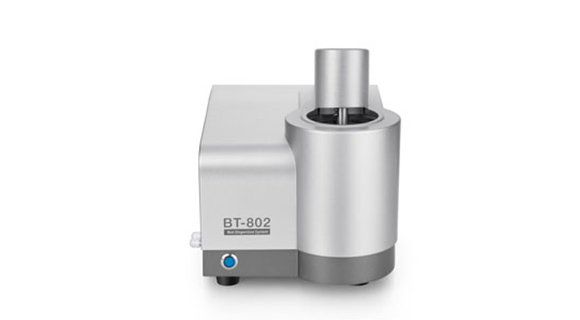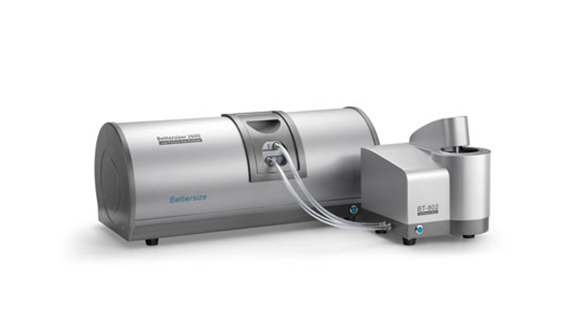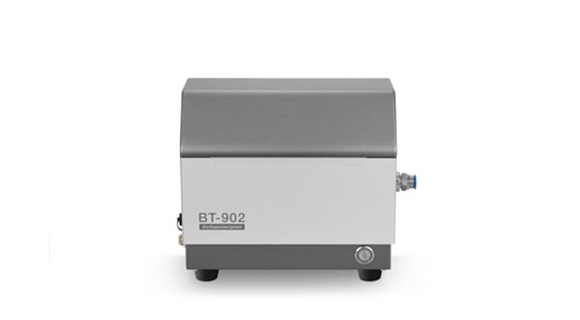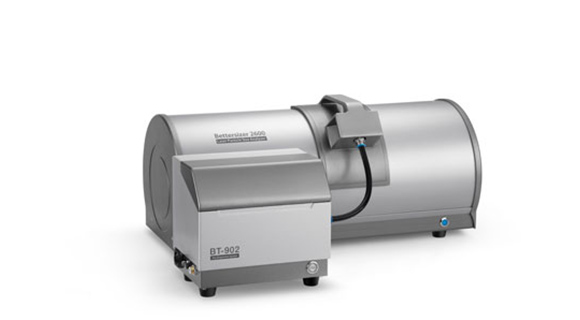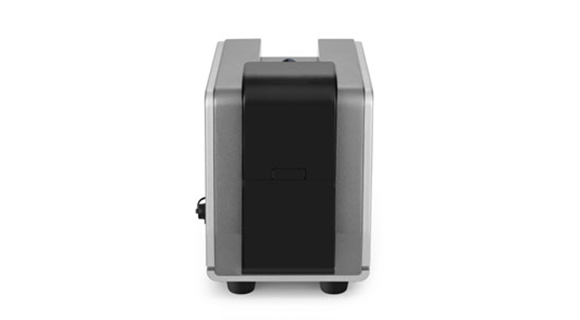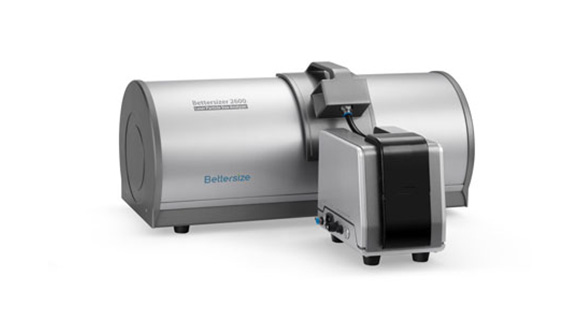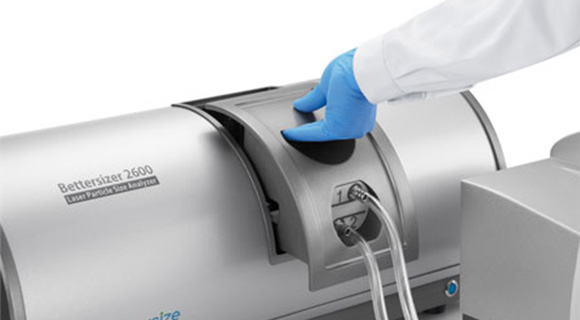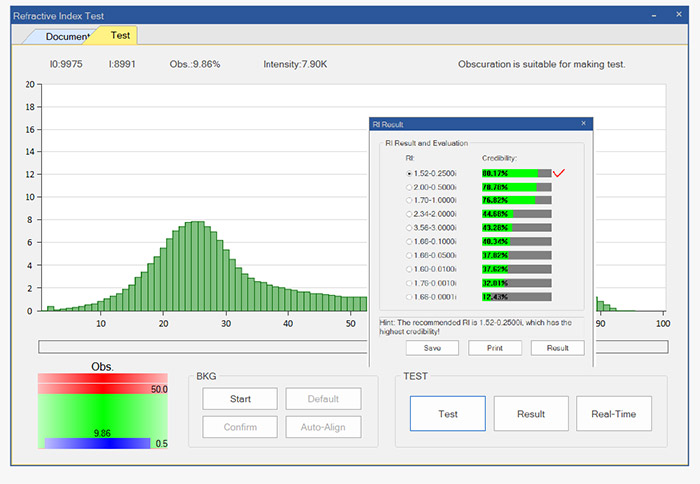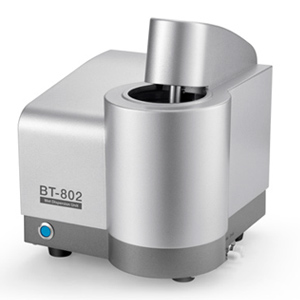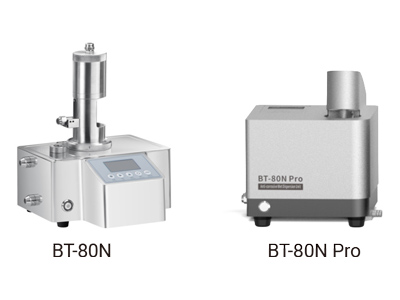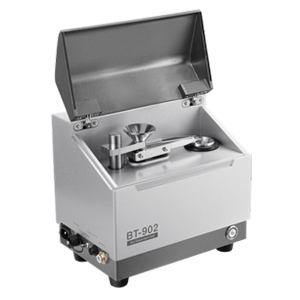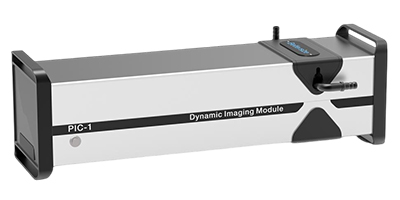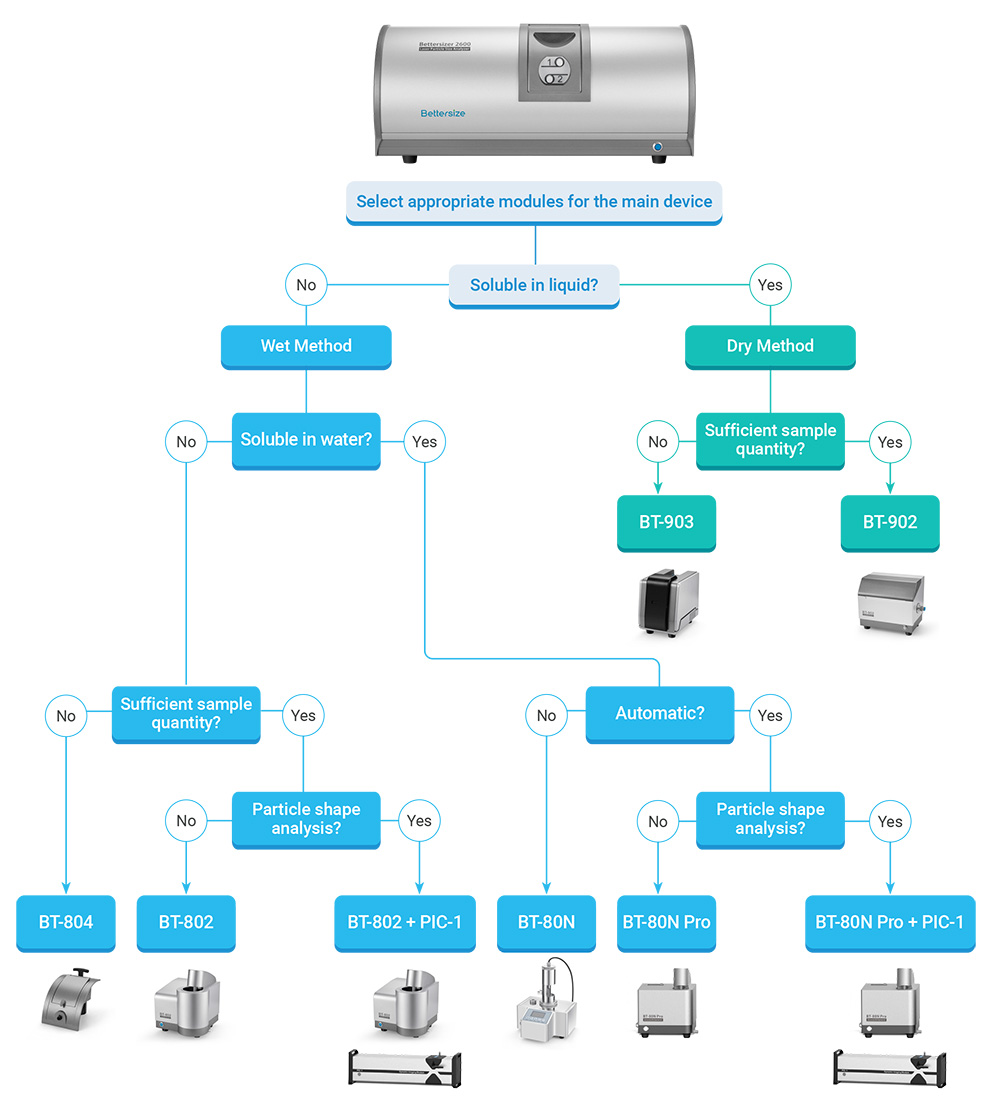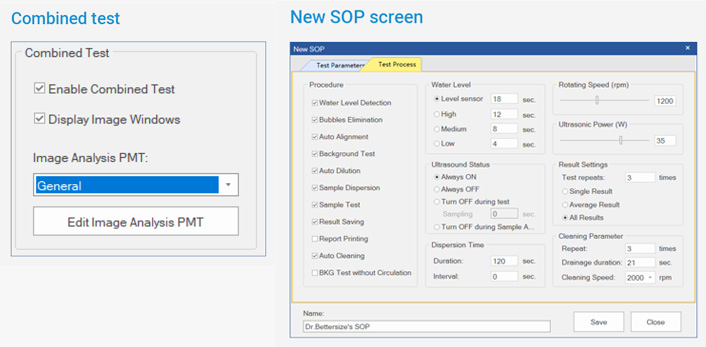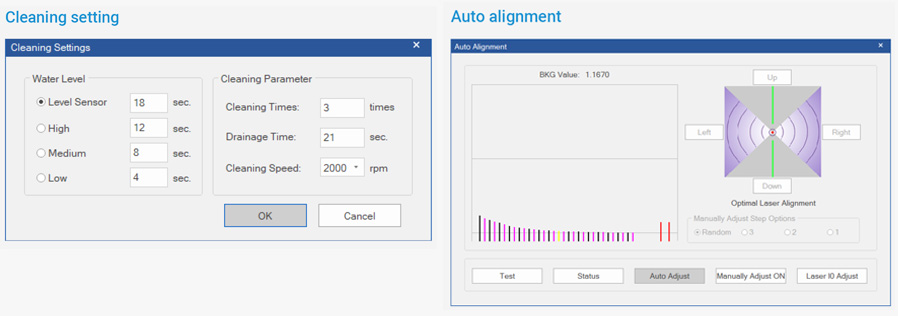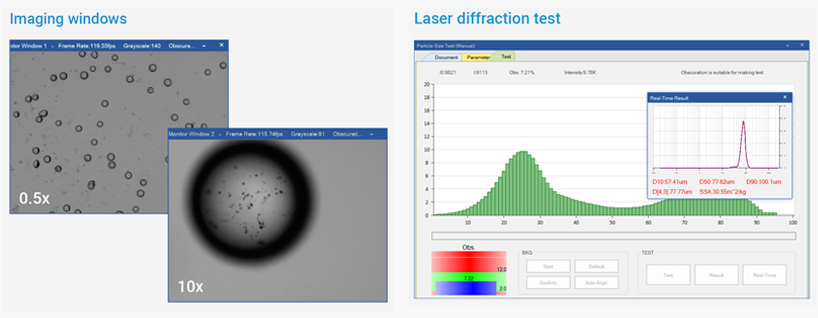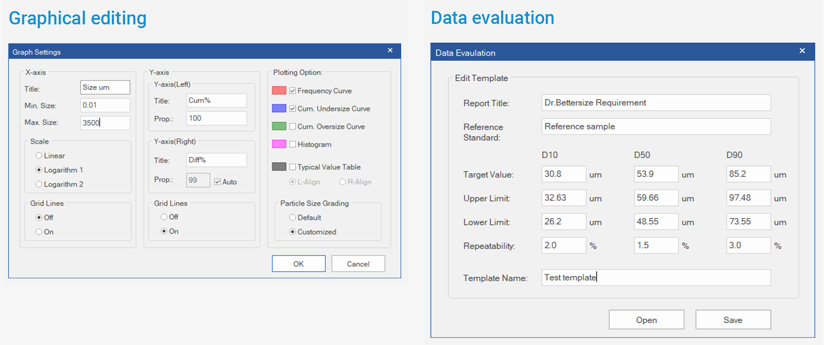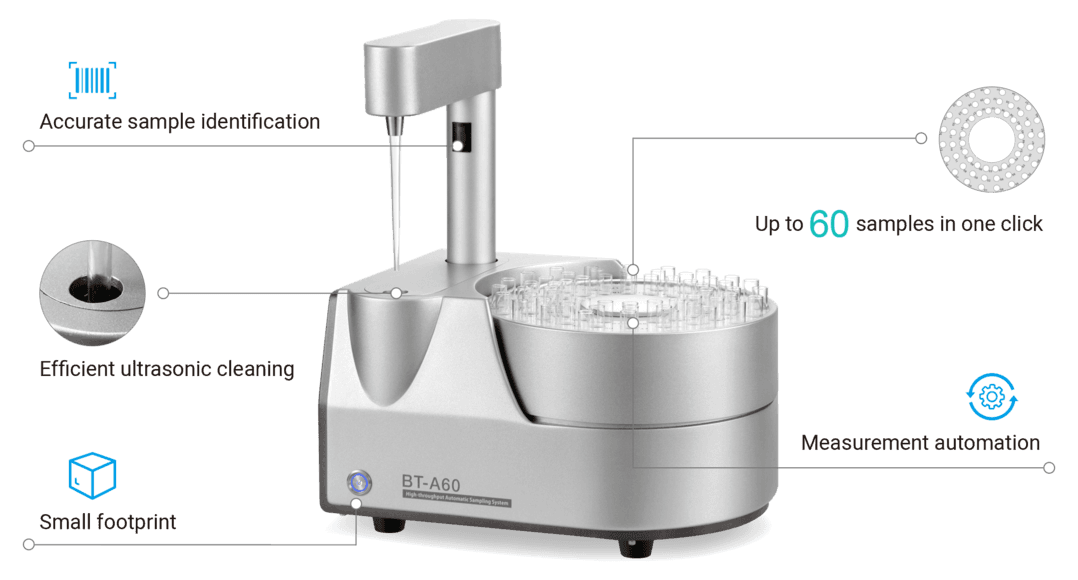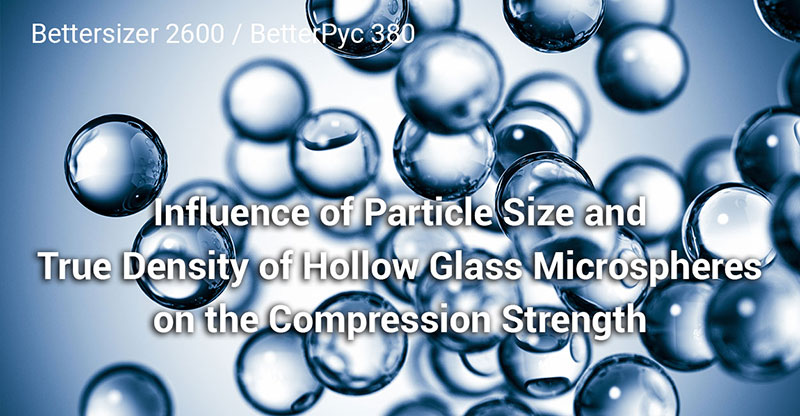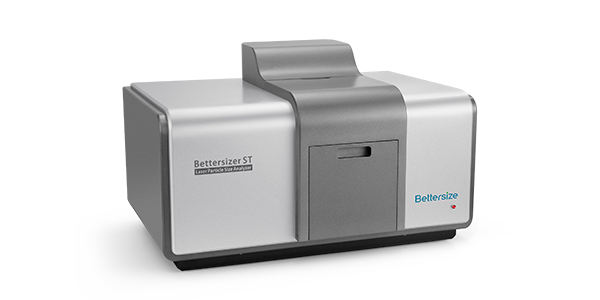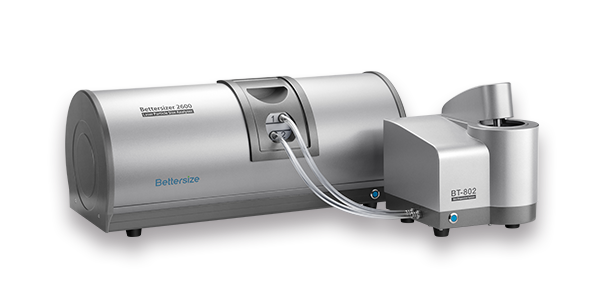Bettersizer 2600은 레이저 회절 기술을 활용해 0.02μm부터 2,600μm까지의 입자 크기를 측정할 수 있습니다. 모듈형 설계를 통해 다목적 기능을 제공하며, 동적 이미징 모듈을 사용해 레이저회절법과 이미징 분석을 결합하여 측정할 수 있습니다. 이를 통해 최대 3,500μm까지 측정 범위가 확장되며, 입자의 크기뿐만 아니라 형상 분석도 가능합니다. 또한, 유연한 분산 모듈을 갖추어 건식과 습식 분산 방식을 모두 지원해 다양한 측정 요구에 대응합니다.
특징 및 장점
- ● 넓은 측정 범위: 0.02 ~ 2,600 μm (습식), 0.1 ~ 2,600 μm (건식), 2.0 ~ 3,500 μm (동적 이미징)
- ● 듀얼 시스템: 레이저 회절 및 동적 이미징
- ● 고급 레이저 회절 시스템: 푸리에 및 역푸리에 설계의 조합
- ● 92개 구형 검출기 배열: 0.016° ~ 165°의 광 신호 감지
- ● 레이저 회절 시스템의 자동 정렬: 수동 조정 필요 없음
- ● 모듈형 이중 카메라 이미징 시스템: 24가지 입자 형상 정보를 제공
- ● 다양한 분산 유닛: 습식 및 건식 분산 유닛
- ● 소프트웨어: 효율적이고 사용하기 쉬움
- ● ISO 13320, 21 CFR Part 11, USP <429>, ISO 13322-2 준수
동영상
How to Install and Operate Bettersizer 2600 
Bettersizer 2600 | Laser Diffraction Particle Size Analyzer (Wet & Dry) 
Snippet - How to Measure Particle Size of Coffee Powder 
Ask an Expert! Introducing Bettersizer 2600 
A Brief Introduction to Laser Diffraction | Fundamentals of Bettersizer 2600 
Bettersizer 2600 Demonstration with Corundum (Al2O3) sample 
How to Measure Particle Size of Cosmetics 
How to Measure Particle Size of Coffee Powder 
Bettersizer 2600 Overview | Laser Diffraction Particle Size Analyzer (Dry & Wet Dispersions) 
개요
제품 개요
분산 유닛 (옵션)
모듈 선택 안내
소프트웨어
제품 사양
오토샘플러
Bettersizer 2600를 선택하는 이유
Bettersizer 2600은 레이저 회절과 동적 이미징의 이중 광학 시스템을 통해 입자 분석에서 뛰어난 성능을 제공합니다. 이 두 시스템의 조합은 입자의 특성을 포괄적으로 분석할 수 있게 해 주어, Bettersizer 2600을 고급 입자 분석을 위한 필수 도구로 만들어 줍니다.
레이저 회절 시스템은 두 개의 강력한 특허로 지원되어 ISO 13320을 준수하며, 정밀하고 신뢰할 수 있는 입자 크기 분석 결과를 제공합니다. 이로 인해 다양한 산업 및 응용 분야에서 새로운 성능 수준을 달성할 수 있습니다. 모듈식 디자인 덕분에 Bettersizer 2600은 동적 이미징 시스템을 손쉽게 통합하여 측정 범위를 확장하고 ISO 13322-2에 준수하는 실시간 입자 형상의 개별 및 정량적 분석을 제공합니다.
레이저 회절법 Laser Diffraction System
1. 특허 기술을 기반으로 입자 분석이 더욱 정확하게
1.1 푸리에 및 역푸리에 설계의 조합 Combination of Fourier and Inverse Fourier Design
Bettersizer 2600은 푸리에 및 역푸리에 설계의 조합에서 뛰어난 성능을 발휘합니다. 이 레이저 시스템 구조는 총 92개의 탐지기를 포함하고 있으며, 전방, 측면, 후방 탐지기로 구성되어 있습니다. 광범위하게 분포된 구형 탐지기 배열을 갖춘 Bettersizer 2600은 0.016°에서 165°까지의 넓은 각도 범위에서 빛 신호를 감지할 수 있어, 작은 입자와 큰 입자 모두를 정밀하게 측정할 수 있습니다.
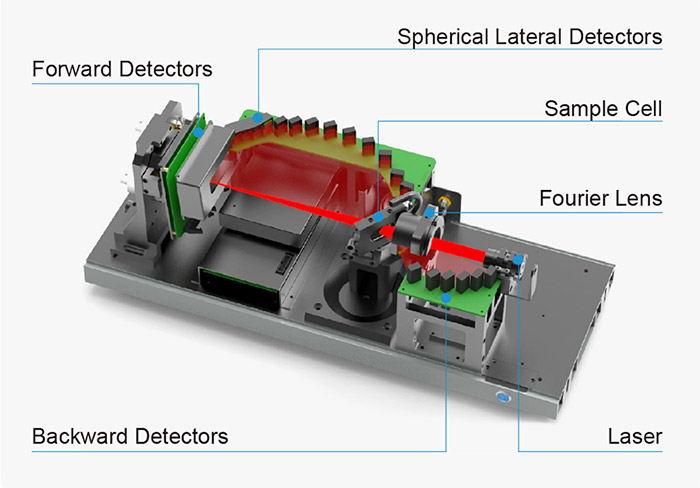
내부 반사(Total internal reflection)는 빛이 밀도가 높은 매질(유리)에서 밀도가 낮은 매질(공기)로 이동할 때 발생하며, 입사각이 임계각을 초과하면 나타납니다. 이 현상은 빛이 탈출할 수 있는 각도를 제한합니다. Bettersizer 2600의 혁신적인 샘플 셀은 경사 디자인을 통해 내부 반사를 효과적으로 최소화합니다. 이로 인해 더 많은 빛 신호가 검출기에 도달하여 측정의 신뢰성이 향상되고, 보다 포괄적인 샘플 정보를 확보할 수 있습니다.
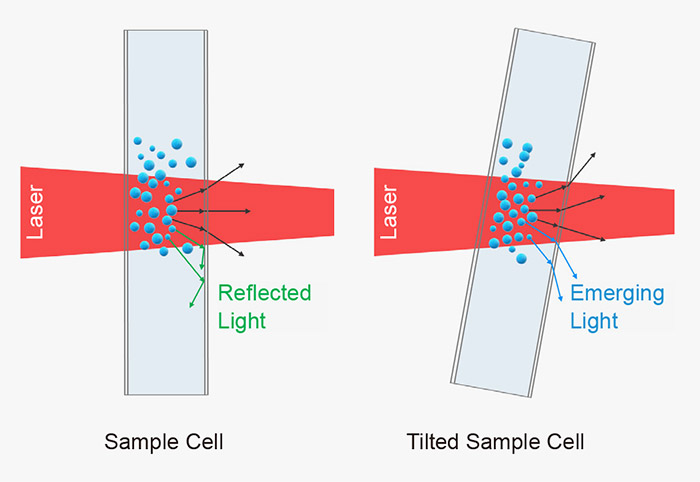
1.2 굴절률 측정
Mie 이론에 따르면, 레이저 회절법을 통한 입도 측정은 다양한 요인으로 인해 특히 도전적일 수 있습니다. 이러한 요인은 다음과 같습니다:
-
- 굴절률이 완전히 알려지지 않은 샘플
- 비균질 화학 조성을 가진 샘플
- 전반적인 물질과 비교해 현저히 다른 입자 광학적 특성을 가진 샘플
- 상당히 강한 광학 분산을 가진 샘플 (작은 Abbe 수)
| 샘플 | 굴절률(문헌) | 굴절률(측정값) |
| CaCO3 | (1.53 - 1.65) - 0.1i | 1.62 - 0.1i |
| BaSO4 | 1.65 - 0.1i | 1.68 - 0.1i |
| ZnO | 2.008 - 0.1i | 2.02 - 0.1i |
| Carbon black | 1.88 - 0.55i | 2.02 - 0.1i |
| Al Powder | 1.4 - 3.9i | 1.42 - 3.0i |
| SiO2 – Quartz | 1.54 - 0.00i | 1.54 - 0.01i |
이러한 도전 과제를 해결하기 위해, 굴절률을 결정하는 것이 가장 효과적인 솔루션 중 하나입니다. Bettersizer 2600은 다음과 같은 기능을 제공합니다:
-
- 알려지지 않은 굴절률 샘플의 굴절률을 측정
- 특성이 불확실한 샘플 측정
- 특정 광 파장에서의 데이터를 검증
- 실시간 입도 분포 측정을 위한 핵심 매개변수를 제공
2. 입도 분석 성능
2.1 넓은 측정 범위
이 장비는 92개의 검출기가 장착된 레이저 시스템 설계 덕분에 0.016°에서 165°까지의 매우 넓은 각도 범위를 활용하여 0.02 μm에서 2,600 μm까지의 측정 범위를 달성합니다. 이로 인해 나노 스케일부터 밀리미터 스케일까지 모두 커버할 수 있습니다.
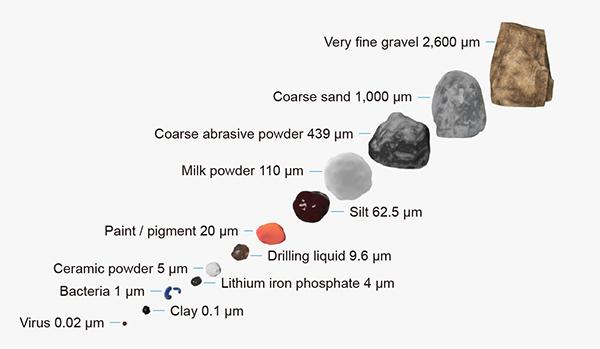
2.2 높은 분해능
The Bettersizer 2600 is capable of distinguishing different samples with varying particle sizes within a single measurement due to its high-resolution analysis ability.Bettersizer 2600은 높은 분해능 덕분에 한 번 측정에서 서로 다른 입도를 가진 샘플을 구분할 수 있습니다.
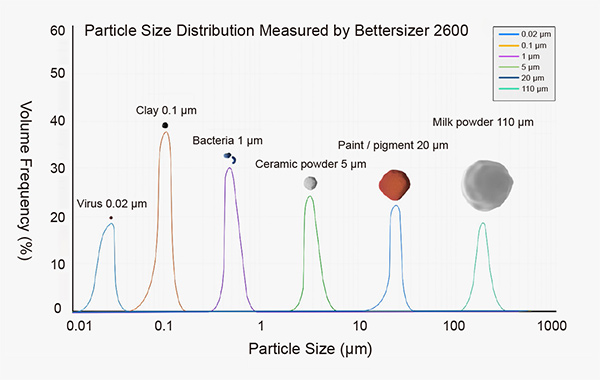
2.3 높은 감도
샘플을 서서히 다른 샘플에 추가할 때, Bettersizer 2600은 곡선에서 입자 크기 분포의 변화를 표시하여 뛰어난 감도를 검증합니다.
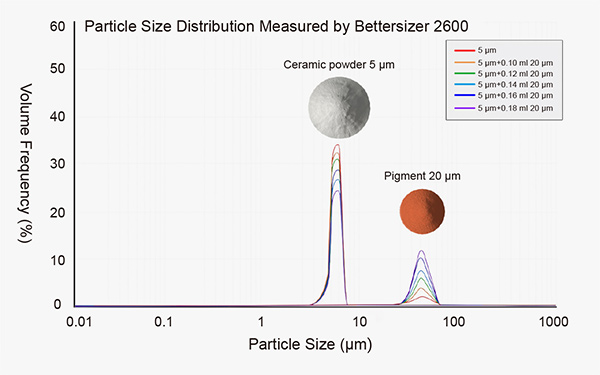
동적 이미징 기술 Dynamic Imaging System
1. PIC-1: 모듈식 듀얼 카메라 이미지 측정 시스템
PIC-1은 듀얼 카메라가 내장된 동적 이미징 모듈로, Bettersizer 2600과 함께 작동합니다. 분산 시스템이 시료 셀을 통해 입자를 이송하는 동안 고속 카메라가 입자 이미지를 캡처하여 실시간 분석을 위해 디지털 형식으로 변환합니다. 이 기능은 단순한 입도 분포를 넘어, 과학자, 연구자 및 엔지니어가 입자 형상을 활용하여 입자를 더욱 깊이 이해할 수 있도록 지원합니다.
듀얼 카메라 이미징 시스템
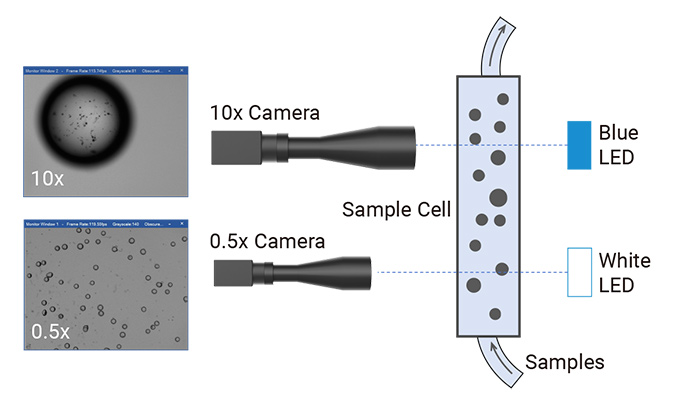
2. 모듈형 이미징 기술로 넓어진 통찰력
2.1 확장된 측정 범위
레이저 회절법과 이미지 분석법의 완벽한 결합으로 Bettersizer 2600의 측정 범위가 3,500 µm까지 확장되었습니다. 매우 넓은 분포를 가진 시료여도 측정할 수 있습니다.
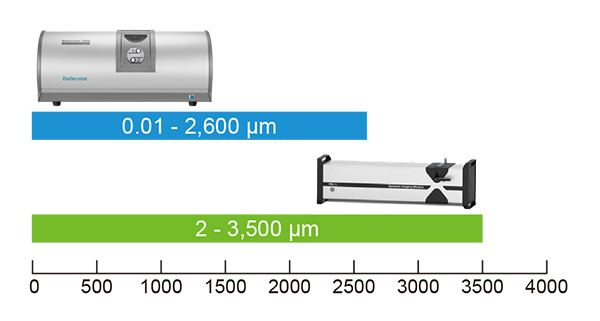
2.2 입자 형상 정보 24가지
PIC-1은 실시간으로 입자 이미지를 캡처하여 포괄적인 데이터를 제공합니다. 이를 통해 고객은 개별 입자를 상세히 연구할 수 있으며, 24가지 입자 크기 및 형상에 대한 정보를 분석하여 입자 특성을 깊이 이해할 수 있습니다.
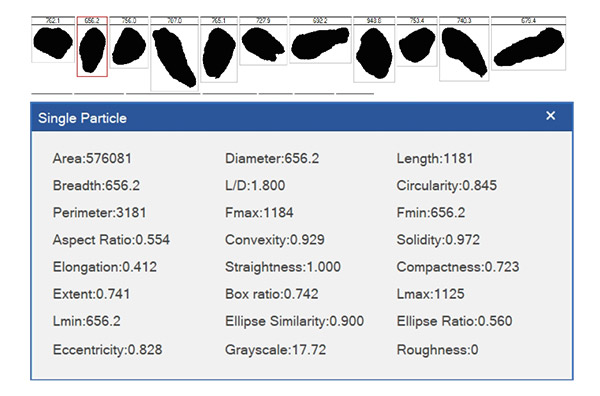
2.3 분말 일관성 유지를 위한 큰 입자를 검출
레이저 회절법과 이미지 분석의 조합은 고르게 분포된 샘플 내에서 통계적으로 저평가된 큰 입자(예: 응집체, 거품 등)를 민감하게 감지할 수 있습니다.
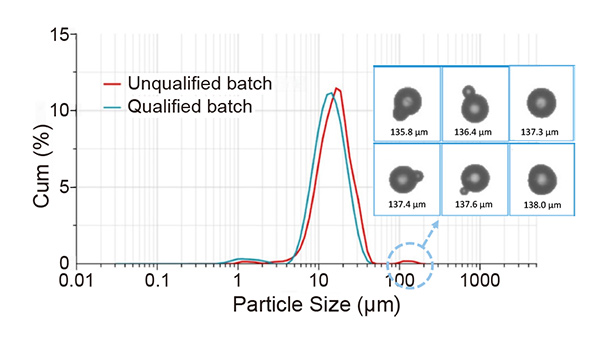
Citations
- Bettersizer 2600
Functional redundancy as an indicator for evaluating functional diversity of macrobenthos under the mussel raft farm near Gouqi Island
DOI: 10.1016/j.aquaculture.2023.740024 Read ArticleZhejiang Ocean University | 2024Biological traits analysis (BTA) helps to evaluate the effects of different environmental variables on the traits-based functional composition of macrobenthos. However, research on functional traits of macrobenthos under mussel farming is limited. We investigated the spatial and temporal response of the benthic system in terms of taxonomic and functional diversity to environmental variables of farming and natural stressors resulting from suspended mussel farming near Gouqi Island of eastern China Sea. The functional traits of macrobenthic assemblages under mussel farming were characterized by “medium adult body size”, “vermiform body form”, “high flexibility”, “infauna”, “semi-motile”, “gonochoristic”, “surface deposit-feeders”, “carnivores”, “semi-motile burrowers”, and “tube-dwellers”. Functional redundancy was stable in response to mussel farming stresses among seasons, whereas species diversity showed efficient to evaluate natural variables. Functional diversity was significantly affected by farming stressors rather than natural variables, Further analysis using multivariate methods together with continuous monitoring were highlighted to evaluate the impacts of mussel farming. Our results reinforce the importance of macrobenthic species and functional traits analysis to evaluate human stresses driven impacts in offshore ecosystems. By analysing the environmental variables with different sources, independently, we concluded the main effects of human pressures on macrobenthic community. Such distinction could be particularly effective to isolate variable environmental descriptors and evaluate their effects on functional diversity, making the current approach promising for the evaluation of ecological effects of anthropogenic stressors in aquaculture areas. - Bettersizer 2600
Degradation characteristics and utilization strategies of a covalent bonded resin-based solid amine during capturing CO2 from flue gas
DOI: 10.1016/j.seppur.2023.125621 Read ArticleChina University of Petroleum | 2024In this study, various types of degradation as well as attrition which are possibly encountered in a circulating fluidized bed temperature swing adsorption (CFB-TSA) process, were conducted experimentally to evaluate the stability of a resin-based solid amine sorbent. Other characterizations methods, such as elemental analysis (EA), Fourier transform infrared spectroscopy (FTIR) etc. were applied to further reveal the degradation mechanisms. The results showed that thermal degradation occurs from 140–160 °C due to the decomposition of amine group. The CO2-induced degradation occurs from a higher temperature of 160–180 °C accompanied by the production of urea. Hydrothermal stability is good below 130 °C, but the ionic impurities in steam crystalized on particle surface can accelerate the degradation. Oxidative degradation is the most harmful, which starts at a lower temperature of 70–80 °C with the formation of aldehyde. The existence of H2O in atmosphere can alleviate the oxidative and CO2-induced degradations. The employed sorbent has a very low attrition index of 0.05, which is 1–2 orders lower than typical commercial fluidized bed catalysts. Based on the results of stability evaluation, some design suggestions for proper utilization of this sorbent or other similar resin-based sorbents have been provided in an industrial CFB-TSA process.
- Bettersizer 2600
De-branching of starch molecules enhanced the complexation with chitosan and its potential utilization for delivering hydrophobic compounds
DOI: 10.1016/j.foodhyd.2023.109498 Read ArticleShihezi University | 2024The current study aimed to prepare the complexes between debranched-waxy corn starch and chitosan polymers (DBS-CS), and then investigated their corresponding structural characteristics, rheological property and potent application in Pickering emulsion. The results indicated that the existence of chitosan significantly inhibited starch short-range molecular rearrangement for all DBS-CS samples, which was manipulated by both debranching treatment and chitosan content. Interestingly, this is the first study to reveal that the outstanding peak at 1.8 ppm in 1H NMR spectrum for sample DBS-CS was gradually shifted towards a lower-field region following an increased chitosan content. Moreover, the debranching treatment shifted the crystallinity pattern from A-type to B-type and the relative crystallinity of DBS-CS decreased gradually with the increased content of CS. All samples had a pseudoplastic fluid and shear-thinning behavior with an enhanced shear resistance following the complexation. The DBS-CS was applied in a Pickering emulsion for showing a greater emulsifying stability and a lower gel strength than native NS-CS prepared emulsion. Importantly, the encapsulation ability of curcumin in the DBS-CS emulsion was significantly improved, followed by an increase of 15.45% for its corresponding bioavailability compared to the control. Therefore, this study might highlight a potential carrier for delivering the bioactive substances in a green pattern. - Bettersizer 2600
Heat-induced aggregation behavior of wheat gluten after adding citrus pectin with different esterification degree
DOI: 10.1016/j.foodhyd.2023.109420 Read ArticleGansu Agricultural University | 2024Wheat gluten aggregation during heat treatment is beneficial to the final quality of gluten-based products. Exogenous pectin can affect gluten aggregation. However, the effect of pectin with different degrees of esterification on the heat-induced aggregation behavior of gluten and its possible mechanism are still unclear. Thus, the heat-induced aggregation behavior of gluten after adding pectin with different esterification degree was studied in this study. When the temperature was raised from 25 °C to 95 °C, pectin affected gluten aggregation and was related to the degree of esterification. Specifically, the results of rheological properties and particle size indicated that low-ester pectin improved the viscoelasticity of gluten and promoted gluten aggregation. Thermal properties revealed that enthalpy of gluten added with low-ester pectin (37%) increased from 92.96 J/g to 95.40 J/g during heating process. Structurally, the fluorescence intensity and surface hydrophobicity of gluten added with low-ester pectin (37%) were lower than those added with high-ester pectin (73%). In addition, low-ester pectin (37%) significantly increased the disulfide bond content (from 15.31 μmol/g to 18.06 μmol/g) and maintained β-sheet content of gluten compared with gluten alone at 95 °C, indicating that low-ester pectin was more likely to induce gluten aggregation. However, scanning electron microscope showed that the gluten added with low-ester pectin (46%) exhibited a denser network structure at 95 °C than that added with low-ester pectin (37%). These results will provide a theoretical base for the regulation of gluten aggregation and the quality of gluten-based products by pectin with different esterification degree.
- 1
- 2
- 3
- 4
- 5
- 6
- 84
선별된 리소스
사용후기



